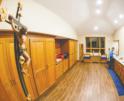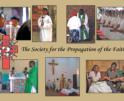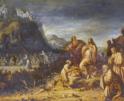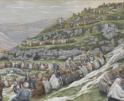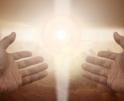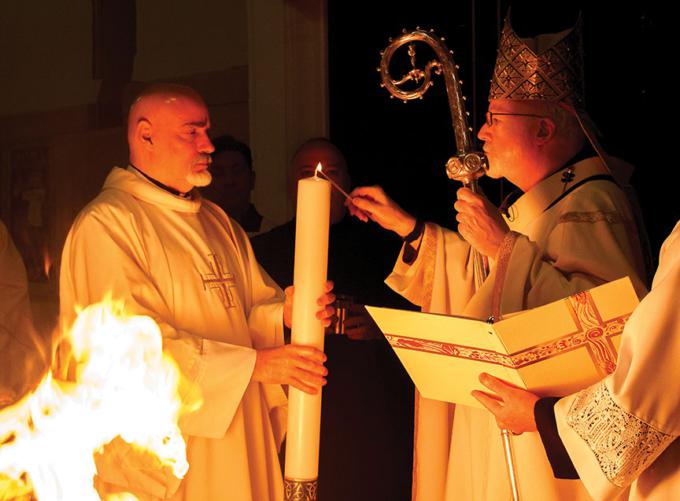
Faith
The Triduum can rightly be called the very heart of the church's year. In fact, the 90 days of Lent and Easter days account for just a bit under a quarter of that year.
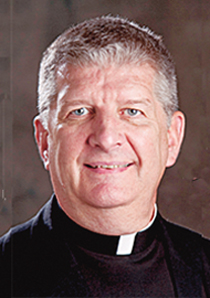
O’Grady
Forty days of Lent to prepare, and 50 days of Easter to celebrate the three hinge days that link Lent and Easter -- the Sacred Paschal Triduum. And these three great days are sandwiched into the intense days we call Holy Week. The Triduum can rightly be called the very heart of the church's year. In fact, the 90 days of Lent and Easter days account for just a bit under a quarter of that year.
Holy Week begins with Sunday of the Passion of the Lord, more commonly called Palm Sunday. The Mass of the day is similar to all Sunday Masses, minus the Gloria. There is, however, the highly recommended Procession with the Palms, which includes their blessing. The Gospel proclaimed is that of the Passion Narrative, which this year is the one from the Gospel of Mark. It's a good idea to have copies of the Passion for those who will proclaim it; the solemnity is enhanced by their not relying on missalettes. An excellent way for all to prepare is to read the readings of this day, and all the days following (see bible.usccb.org).
Monday, Tuesday, and Wednesday of this week are days that get us ready for the imminent Triduum. Wednesday has the nickname "Spy Wednesday," as the Gospel proclaimed narrates Judas's betrayal of Jesus.
In many dioceses, including our own, the Chrism Mass is celebrated on one of these days. If you can get to this Mass in your own diocese, it's worth joining the assembly. If you cannot, you can join Boston's Chrism Mass on March 26 via CatholicTV (www.catholictv.org).
The Triduum, although the most sacred of days in the church's calendar and ones which as far as possible Catholics should willingly attend and participate in, consists of three intimately related celebrations, one each day. Some point out that it is truly one celebration spread over three days.
Holy Thursday
The Evening Mass of the Lord's Supper is the only Mass celebrated for Holy Thursday. With the Washing of the Feet and the Procession with the Eucharist following the reception of Holy Communion at the usual time at any Mass, we could say that this Mass emphasizes two important aspects of the ministry of Jesus, both as it occurred in his life and in the sacrament of the Eucharist as he determined it to continue in the church -- "ministerium et mysterium" or "service and sacrament." The church cannot be mission without both.
Good Friday
Good Friday of the Lord's Passion is the principal liturgy for the day. It is the only day in the church's year when Mass cannot be celebrated. There are three parts of this liturgy: The liturgy of the Word with the proclamation of John's account of the Lord's Passion, the Adoration of the Cross, and the Communion Service.
Holy Saturday
At the Vigil in the Holy Night of Easter, this highpoint of the church's year consists of four parts: the Service of Light with the preparation and lighting of the new Paschal Candle; the Liturgy of the Word much extended with seven readings from the Old Testament, one from St. Paul's Letter to the Romans, and a Gospel; the Liturgy of Initiation with the blessing of the Eater water, the baptism and confirmation of the catechumens, and renewal of baptism for the entire assembly; and the Liturgy of the Eucharist when the newly baptized and confirmed Catholics receive the Eucharist for the first time together with their new sisters and brothers in Christ.
Easter Sunday
The Resurrection of the Lord is the Day of Days. The Triduum concludes with Solemn Evening Prayer of Easter on Easter Sunday Evening. Next week's column will be about the Easter season and will pick up from here.
These days can be very busy ones for all those involved in the preparation and celebration. Much of the beauty of these days is thanks to a lot of unseen effort.
Bishops, priests, and deacons are preparing brief (the Missal's words, not mine) homilies for these celebrations, which can be both long and complex. But the liturgy itself has an incredible power to preach. The readers, extraordinary ministers, servers, sacristans, parish custodial staff, and those who take care of linens and vessels are all busy and praying as well. And parish musicians -- instrumental, vocal, and choral -- are all rehearsing to lead us in this prayer of prayers.
The wax Paschal candle, indeed all the candles, are to be real and new. The same applies for any floral arrangements. There is an old guide -- "for God the best and the most."
To help parishes, assemblies, and individuals prepare, here are some recommended resources:
-- Holy See's 1988 document on the Paschal Solemnities, still very helpful even after 35 years, available at www.liturgyoffice.org.uk/Calendar/Seasons/Documents/Paschale-Solemnitatis.pdf;
-- "Guide for Celebrating Holy Week and the Triduum" by Corinna Laughlin, Kristopher Seaman and Stephen Palanca;
-- "Glory in the Cross: Holy Week in the Third Edition of The Roman Missal" by Paul Turner;
-- "Three Great Days: Preparing the Liturgies of the Paschal Triduum" by Jeremy Helmes;
-- And for homilists, there is "Awesome Glory: Resurrection in Scripture, Liturgy, and Theology" by Abbott Jeremy Driscoll, OSB.
Recent articles in the Faith & Family section
-
Did you know?Father Robert M. O'Grady
-
Sowing the Seeds of FaithMaureen Crowley Heil
-
Bread left overScott Hahn
-
Scripture Reflection for July 28, 2024, Seventeenth Sunday in Ordinary TimeJem Sullivan
-
What the universal call to holiness entailsDr. R. Jared Staudt

